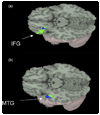Children with reading disorder show modality independent brain abnormalities during semantic tasks
- PMID: 17010394
- PMCID: PMC2710998
- DOI: 10.1016/j.neuropsychologia.2006.08.015
Children with reading disorder show modality independent brain abnormalities during semantic tasks
Abstract
Neuroimaging studies have suggested that left inferior frontal gyrus, left inferior parietal lobule and left middle temporal gyrus are critical for semantic processing in normal children. The goal of the present functional magnetic resonance imaging (fMRI) study was to determine whether these regions are systematically related to semantic processing in children (9- to 15-year-old) diagnosed with reading disorders (RD). Semantic judgments required participants to indicate whether two words were related in meaning. The strength of semantic association varied continuously from higher association pairs (e.g., king-queen) to lower association pairs (e.g. net-ship). We found that the correlation between association strength and activation was significantly weaker for RD children compared to controls in left middle temporal gyrus and left inferior parietal lobule for both the auditory and the visual modalities and in left inferior frontal gyrus for the visual modality. These results suggest that the RD children have abnormalities in semantic search/retrieval in the inferior frontal gyrus, integration of semantic information in the inferior parietal lobule and semantic lexical representations in the middle temporal gyrus. These deficits appear to be general to the semantic system and independent of modality.
Figures



References
-
- Aram DM, Ekelman BL, et al. Preschoolers with language disorders: 10 years later. Journal of Speech and Hearing Research. 1984;27:232–244. - PubMed
-
- Bitan T, Cheon J, et al. Developmental changes in the neural correlates of phonological processing. Journal of Cognitive Neuroscience. 2006 submitted for publication.
Publication types
MeSH terms
Grants and funding
LinkOut - more resources
Full Text Sources
Medical
Miscellaneous

